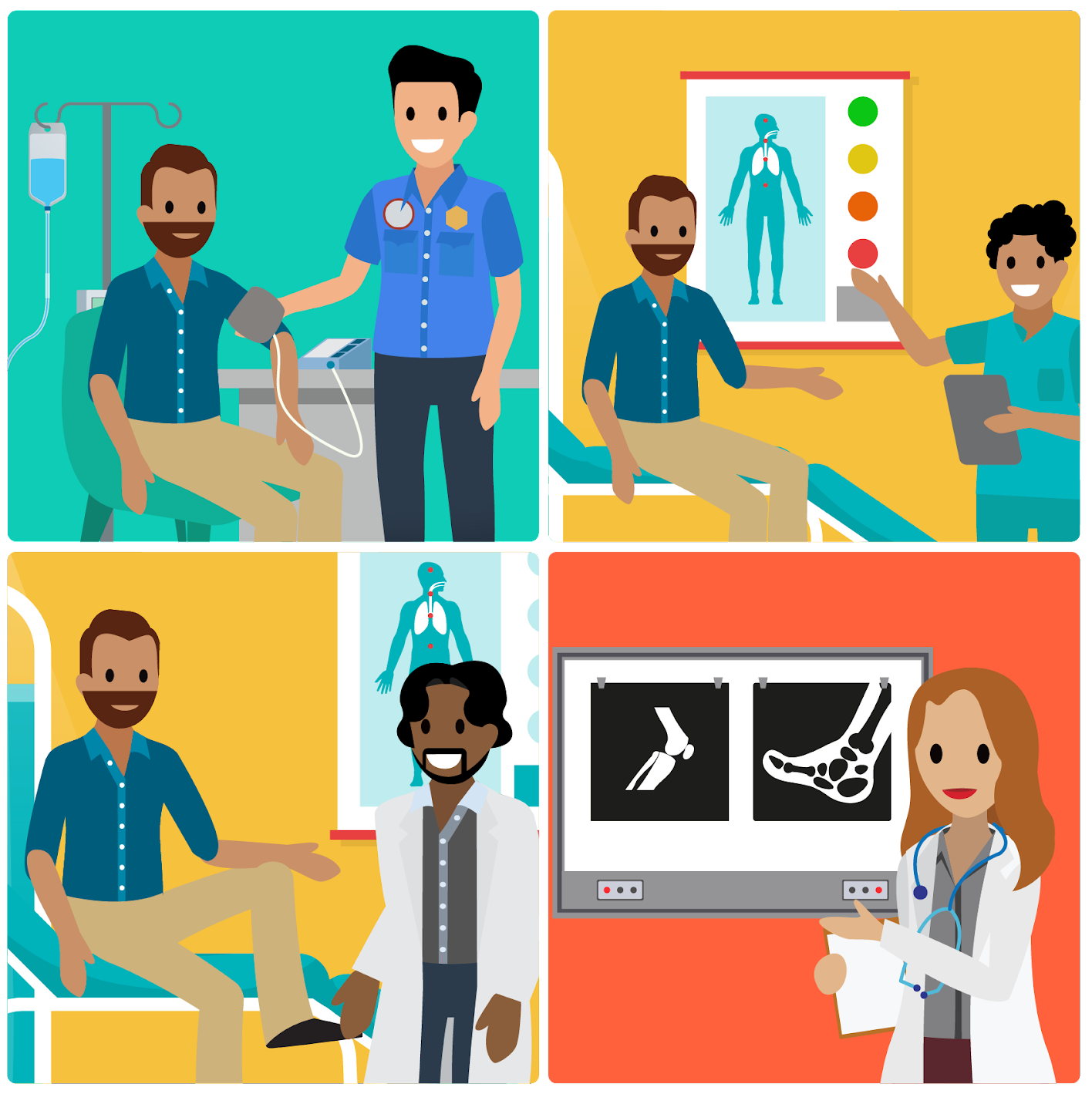Review Provider Products, Customers, and Trends
Learning Objectives
After completing this unit, you’ll be able to:
- Describe the main provider products and services.
- Discuss providers’ most common customers.
- Identify major trends impacting providers.
Provider Products and Services
When Alvin breaks his leg, providers offer him several products and services. On the way to the hospital, the paramedics take his vital signs and immobilize his leg with temporary splints. The nurse in the ER assesses his pain level. The doctor examines Alvin and orders the x-ray, and the radiologist interprets the x-ray as she diagnoses the injury.
It’s easy to see the providers in this scenario, but can you spot the products and services as well?

Provider products and services in the healthcare system can be easy to spot, and you probably have some level of personal experience with them. They typically fall into one of these areas.
Treatment for illnesses, diseases, or injuries:
- Routine exams
- Management of chronic conditions
- Physical, occupational, and speech therapy
Diagnostic testing:
- Ultrasound
- X-ray
- Computed tomography (CT)
- Magnetic resonance imaging (MRI)
- Positron emission tomography (PET)
- Mammography
Facilities where care takes place:
- Hospitals
- Skilled nursing and rehabilitation facilities
- Urgent care centers
- Home care
- Surgery centers
- Dental offices
These are the offerings, but who do the providers give or sell them to?
Providers’ Customers
We all fall into one group of customers—the patients. Patients receive and sometimes pay for provider services. Other customer groups are the insurance carriers and the government, both of which pay for services. And finally, third-party providers also sell their services to other provider organizations, like anesthesiologists who sell their services to hospitals, or diagnostic imaging and laboratory centers that contract with providers for their services.
Provider Trends
One trend affecting payers, providers, and the pharmaceutical sector is the move from fee-for-service to value-based care. This means payers compensate providers for clinical outcomes and quality of care, not for the quantity of services provided.
How does this affect patients? Providers in a value-based care model need data to demonstrate the effectiveness and efficiency of treatment. Providers have to report on specific metrics and show how they meet predefined minimum results.
Here are four of the primary trends providers focus on today.
Trend: Personalize the experience.
The world is becoming smarter and more connected. Across the globe, patient expectations are driving cross-industry transformations. With real-time, connected, and instantaneous digital experiences, patients have come to expect services faster than ever before.
While this is an opportunity for providers to deliver better end-to-end patient experiences, it also challenges them to transform quickly. Technology silos and legacy systems can make it difficult to personalize a patient’s experience, so delivering a unified solution is key. Healthcare providers are now looking to personalize the experience by creating more opportunities to better know their patients, providers, and members.
Trend: Efficiently manage aging and sick populations.
Providers are becoming more aware of the social determinants of health (SDOH), which are the conditions in which people are born, live, work, and age. A big portion of healthcare spend is related to the care of patients with chronic diseases.
Risk stratification, which is the process of assigning health risk to a patient, and then modifying their care based on the risk, has become a key focus for healthcare providers. By surfacing critical data, providers are empowered to better understand and manage their patients with chronic conditions.
Trend: Drive revenue growth while reducing costs.
Healthcare providers are seeking new ways to attract and retain patients as healthcare costs continue to rise. Many organizations are moving toward virtual care programs to reduce costs, deliver personalized care, and serve rural populations. Improving operational efficiencies and reducing costs are big concerns for providers.
The average patient is increasingly involved in choosing where to obtain their care. Faced with high-deductible plans and rising out-of-pocket costs, patients are insistent in being involved in decision-making. Patients have come to expect data transparency and seamless digital experiences.
Trend: Compete with new entrants, mergers, and partnerships.
New entrants in the providers space—such as retail pharmacies offering expanded healthcare services—are disrupting the healthcare industry by announcing new strategies and cheaper healthcare offerings.
Providers, payers, and health tech companies are shifting from traditional business models to a more blended model like “Payviders,” which are provider organizations that operate their own health plans, and business-to-business-to-consumer (B2B2C) models. Gone are the days where patients were satisfied with receiving services in historically traditional places like hospitals. Today, patients expect access to healthcare anytime, anywhere. To meet these growing expectations, providers are reinventing the healthcare experience to reflect the retail experience, where a variety of services are offered from a number of different channels instantaneously.
These trends in the provider space magnify how the healthcare industry is changing to revolve around the consumer and patient experience—it’s all about making people better. Providers–doctors, nurses, physical therapists, and other clinical staff–work hard to take care of their patients.
Resources
- Video series: The Connected Patient Journey
- Stat article: Chronic diseases are taxing our healthcare system and our economy